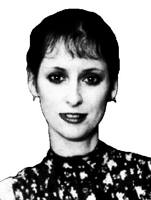
|
The Society of Folk Dance Historians (SFDH) Camille Brochu
[
Home |
About |
Encyclopedia | CLICK AN IMAGE TO ENLARGE |

|
BACKGROUND
Information: Camille Brochu, teacher of Bulgarian, Canadian, and French Canadian dance.
Camille Brochu was born and raised in Montréal, Canada, and has been involved in dance since childhood, having studied ballet for six years. In her adolescent years, Camille continued dancing in a church hall on Saturday nights and joined an East European performing group. After a year at a teacher's college, the dance instinct overcame her: she auditioned for the National Folklore Ensemble Les Feux-Follets (Will-o''the-Wisp), and from 1964 to 1967, was a professional Québecois dancer and singer with that troupe.
In 1968, Camille made her first trip to Europe, joining the tour of the Seattle group, Koleda, led by Dennis Boxell, who had formerly lived in Montréal. Splitting off from the group tour, she ventured off alone into Bulgaria. In Sofia, she visited Ensemble Sredets, from whom she learned Dobrudžanska Rŭka (Dobrudjan hand). Upon return to Canada, she showed the dance to Yves Moreau. It caught on throughought the United States, thanks to Yves' teaching.
In 1979, she moved from Montréal to Toronto and became the Artistic Director and Choreographer of Les Danseurs de la Nouvelle France, as well as Co-founder and Director of the Multicultural Traditional Arts Association.
As a recipient of a Secretary of State grant, she did field reserch of Southern Ontario step-dancing, comparing it to the Québecois style. In addition to teaching engagements in Canada, she has taught in the United States at the Maine and Stockton camps, in Chicago and Ann Arbor, and with the Hermans in New York.
Camille Brochu is a graduate of the Dance Department at UCLA. She also has been a Research Assistant, Teaching Assistant, Conference Director, Associate Editor, and Lecturer.
A research grant facilited her travel to her native Québec for thesis fieldwork, interviewing and videotaping at village dance events. After her MA degree, she completed her PhD.
She really has dual careers – ethnic dance and music as a passion and administrative work to make a living. In 1982, she entered York University to study Anthropology and Ethnomusicology and emerged with an Honors BA. Next, she quit her government job in the Office of Francophone Affairs and, with the aid of a fellowship, embarked on graduate studies in Dance Ethnology.
Although she has a well-rounded folk dance background, Camille maintains a strong affiliation with her home culture and is most familiar with the dances of Québec. The step dancing (also called clogging) has French and Anglo-Celtic influences dating from the 1700s, but has evolved over the centuries into a distinct genre. The primary instrument is the fiddle; the accordion was added in the 1850s and other instruments later. A Québecois dance widely known in the United States is La Bastringue. In the rural villages of Québec, the traditional dances are still done at weddings and in community halls.
Dances Camille has taught include Beranče, Ćupurlika, Dobrudžanska Rŭka, Gigue, Kjustendilska Rŭčenica, La Clog-Valse, La Giguese, Le P'tit Train, Les Presentations, Quadrille de la Beauce, Quadrille du Richelieu, and Tik.
This page © 2018 by Ron Houston.
Please do not copy any part of this page without including this copyright notice.
Please do not copy small portions out of context.
Please do not copy large portions without permission from Ron Houston.